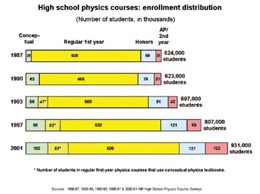By Pamela Zerbinos
More high school students are taking physics courses than ever before, according to a study released in July by the American Institute of Physics.
The study, which examines the 2000-2001 school year, is the latest in a series of reports issued by the AIP every four years.
The previous study, released in 1999, found that high school enrollment in physics classes had reached 28% in 1997, a post-World War II high. By 2001, that number had climbed to 31%, or 931,000 students.
 |
In addition to the overall rise in enrollment, the physics curriculum has grown more varied over the years as schools have moved away from a one-size-fits-all approach. There has been an increase in conceptual physics classes, which are less math-intensive than their standard physics counterparts. Some regular physics classes also use a conceptual approach, bringing the percentage of students in conceptual classes up to 21% from 18% in 1997. Thirteen percent of students take an accelerated or honors first-year course, and 11% sign up for Advanced Placement or second-year courses.
Another important enrollment trend is the increasing participation of girls, who are now enrolling in physics courses in almost equal numbers to boys, and now constitute 46% of all physics students. However, they continue to be underrepresented in advanced physics courses, and only a quarter of high school physics teachers are female.
The rise in enrollment has crossed racial and ethnic lines as well, with Asians, whites, blacks and Hispanics all reporting increased numbers of physics students. Although that signals that traditionally underrepre- sented minorities have not fallen farther behind, their exposure to high school physics courses remains low.
In a given geographical area, schools that teachers describe as catering to poorer students are considerably less likely to offer physics courses. In schools whose students are described as "much better off than average," 45% of students are enrolled in some sort of physics course; in schools described as "much worse off than average," that number drops dramatically to 22%.
Nearly half of all high school physics teachers majored or minored in physics or physics education while in college, a number that has been slowly increasing. The rise in enrollment has made it possible for more of these teachers to specialize in physics, and now 56% of teachers describe themselves as specialists (up from 48% four years earlier). Along the same lines, the percentage of teachers teaching exclusively physics is up from 19% to 23%, but 48% still teach primarily non-physics courses.
Pay for physics teachers continues to rise at a rate slightly above that of the inflation rate, but is still significantly below the median salary for physics-degree holders who go into other fields. The current median salary for a new physics teacher is $28,000, up $3,000 from the previous study.
The problems teachers cite as keeping them from being more effective have remained largely the same. Inadequate funding for equipment and supplies is the chief concern, with 34% of teachers pointing to it as a serious concern. But this is down from 39% in the 1997 study, and other problems with labs and funding-inadequate space, not enough preparation time-have decreased by a similar amount.
On the other hand, there has been an increase in the number of teachers who cite inadequate mathematical preparation of incoming students as a problem.
"While less effective mathematics instruction may seem the obvious culprit," said Michael Neuschatz, the director of the study, "an alternative explanation may be the fact that enrollment is coming from a broader student base and is therefore more likely to include groups of students traditionally less well- prepared mathematically."
A similar pattern may account for the parallel rise in percentage of teachers who said their students didn't think physics was important. In previous, lower-enrollment years, the students signing up for physics were more likely to be the most enthusiastic about science. With enrollment growing and reaching out to students who might not have signed up a decade ago, the greater variety of attitudes is understandable.
The study is available online at http://www.aip.org/statistics/trends/highlite/hs2001/hshigh.htm. A limited number of hard copies are available by e-mailing mmcfarli@aip.org.
©1995 - 2024, AMERICAN PHYSICAL SOCIETY
APS encourages the redistribution of the materials included in this newspaper provided that attribution to the source is noted and the materials are not truncated or changed.
Associate Editor: Jennifer Ouellette
July 2003 (Volume 12, Number 7)
Articles in this Issue

